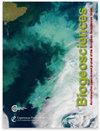评论与综述:利用生物地球化学-阿尔戈浮标扩大初级生产总量和群落生产净量测量的全球覆盖范围
IF 3.9
2区 地球科学
Q1 ECOLOGY
引用次数: 0
摘要
摘要本文概述并演示了利用生物地球化学-Argo(BGC-Argo)浮标数据量化初级生产总量(GPP)和群落净生产量(NCP)的新兴浮标方法。最近发表的文章介绍了基于使用单个剖面仪或 BGC-Argo 浮漂综合探测上层海洋氧气或颗粒有机碳浓度昼夜振荡的 GPP 方法。NCP 方法依赖于预算计算,将观测到的示踪剂变化划分为时间尺度大于 1 d 的物理或生物过程。目前,通过在局部范围内连续或同时布放浮标,可以实现近周分辨率的多年期 NCP 时间序列。但是,结果对预算计算中使用的示踪剂的选择以及不同 NCP 方法中使用的预算参数的不确定性很敏感。目前,利用整个 BGC-Argo 阵列的数据可以进行十年期、全流域的 GPP 计算,但更精细的时空分辨率需要更多的浮标布放来构建昼夜示踪曲线。如果浮标以非整数间隔(如 5.2 或 10.2 d)布放,预计由 1000 个浮标组成的全球 BGC-Argo 浮标阵列应足以实现 10∘ 纬度分辨率的年度 GPP 估算。解决目前浮标法的局限性,应能提高海洋 GPP 和 NCP 测量的时空覆盖率,促进全球尺度碳输出潜力的确定、卫星初级生产算法的培训和生物地球化学数值模式的评估。本文旨在促进海洋学界更广泛地采用浮标 GPP 和 NCP 方法,将其作为单独或组合工具,并推动其持续发展。本文章由计算机程序翻译,如有差异,请以英文原文为准。
Reviews and syntheses: expanding the global coverage of gross primary production and net community production measurements using Biogeochemical-Argo floats
Abstract. This paper provides an overview and demonstration of emerging float-based methods for quantifying gross primary production (GPP) and net community production (NCP) using Biogeochemical-Argo (BGC-Argo) float data. Recent publications have described GPP methods that are based on the detection of diurnal oscillations in upper-ocean oxygen or particulate organic carbon concentrations using single profilers or a composite of BGC-Argo floats. NCP methods rely on budget calculations to partition observed tracer variations into physical or biological processes occurring over timescales greater than 1 d. Presently, multi-year NCP time series are feasible at near-weekly resolution, using consecutive or simultaneous float deployments at local scales. Results, however, are sensitive to the choice of tracer used in the budget calculations and uncertainties in the budget parameterizations employed across different NCP approaches. Decadal, basin-wide GPP calculations are currently achievable using data compiled from the entire BGC-Argo array, but finer spatial and temporal resolution requires more float deployments to construct diurnal tracer curves. A projected, global BGC-Argo array of 1000 floats should be sufficient to attain annual GPP estimates at 10∘ latitudinal resolution if floats profile at off-integer intervals (e.g., 5.2 or 10.2 d). Addressing the current limitations of float-based methods should enable enhanced spatial and temporal coverage of marine GPP and NCP measurements, facilitating global-scale determinations of the carbon export potential, training of satellite primary production algorithms, and evaluations of biogeochemical numerical models. This paper aims to facilitate broader uptake of float GPP and NCP methods, as singular or combined tools, by the oceanographic community and to promote their continued development.
求助全文
通过发布文献求助,成功后即可免费获取论文全文。
去求助
来源期刊

Biogeosciences
环境科学-地球科学综合
CiteScore
8.60
自引率
8.20%
发文量
258
审稿时长
4.2 months
期刊介绍:
Biogeosciences (BG) is an international scientific journal dedicated to the publication and discussion of research articles, short communications and review papers on all aspects of the interactions between the biological, chemical and physical processes in terrestrial or extraterrestrial life with the geosphere, hydrosphere and atmosphere. The objective of the journal is to cut across the boundaries of established sciences and achieve an interdisciplinary view of these interactions. Experimental, conceptual and modelling approaches are welcome.
 求助内容:
求助内容: 应助结果提醒方式:
应助结果提醒方式:


